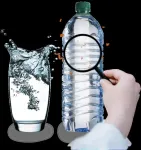(Press-News.org) Maytal Saar-Tsechansky was standing a few meters from Israeli Prime Minister Yitzhak Rabin in 1995, when he was assassinated by a right-wing extremist in Tel Aviv.
“At the time, Rabin was promoting peace with the Palestinians,” says Saar-Tsechansky, professor of information, risk, and operations management and the Mary John and Ralph Spence Centennial Professor at Texas McCombs. “The assassination was the result of a lot of incitement, of some people claiming that he was the enemy of the people.”
Although she typically studies artificial intelligence, the traumatic incident planted a seed for a different interest: how to ease political divisions. She began working on an algorithm that would alert social media users to polarizing content. She also approached Christopher Bryan, associate professor of business, government, and society, to design an intervention that could help persuade them to avoid such content once they were alerted to it.
The intervention — an eight-minute interactive e-learning module — became part of a new megastudy, published two weeks before a bruising presidential election. Bryan and Saar-Tsechansky were among 86 co-authors who devised and tested methods for reducing partisan animosity and antidemocratic attitudes, one person at a time.
The megastudy’s lead researchers selected 25 “treatments” from hundreds of submissions. They included informational videos, games, articles, and writing prompts. Many highlighted likable people of the opposing political party or emphasized traits or values that rival partisans have in common.
In the module by Bryan and Saar-Tsechansky, subjects read about how news media exploit polarization for profit. The module included data showing that the more news a person watches, the more exaggerated and inaccurate are that person’s ideas about people with opposing views.
After viewing the information, subjects were prompted to talk about actions they and others could use to “take control back from the media.”
Of the 25 treatments, theirs proved second most effective in reducing partisan animosity: by 10% compared with a control group that received no treatments. It also had smaller effects on attitudes such as social distrust and opposition to bipartisan cooperation.
“The effects were not huge, but it is possible to mitigate some of these issues. I think it’s very, very encouraging,” Saar-Tsechanksy says.
Pulling Back on Partisanship
In all, the megastudy tested its treatments on more than 32,000 self-identified Democrats and Republicans in the U.S. Its overarching finding was that 23 of the 25 efforts led to statistically significant reductions in partisan animosity, which the researchers define as “dislike for opposing partisans.”
The research, citing studies that partisan animosity grew by 22 percentage points between 1978 and 2016, found that:
The average reduction in partisan animosity was 5 percentage points — equivalent to eight years of the increase seen in recent decades.
The most effective treatment was a video of British people “bonding with one another despite having political disagreements.”
For six treatments, the reductions held for at least two weeks. Bryan and Saar-Tsechansky’s treatment was the most lasting, maintaining 90% of its impact.
The treatments were more limited in reducing other negative attitudes.
Six significantly lessened support for undemocratic practices. The most effective treatments challenged perceptions that opponents were antidemocratic or highlighted “the potentially disastrous consequences of democratic collapse.”
Five reduced support for partisan violence, most notably by showing subjects op-eds in which leaders of their parties rejected violence or campaign ads that endorsed acceptance of election results and peaceful transfer of power.
Both McCombs researchers say the study provides ideas that could be incorporated into civic education or media literacy courses. Saar-Tsechansky hopes it will get the attention of school districts, to help educate teenagers “who already have some critical thinking skills and care about what’s right and what’s wrong.”
She and Bryan see education as the most viable medium for reducing polarization. They say media — particularly cable news — fan the flames of political division to increase ratings, readership, and revenue. Politicians also benefit from this system, so they have little incentive to change it.
Bryan says most Americans are part of an “exhausted majority.” They want Democrats and Republicans to work together to address real problems but feel they’re falling victim to media messaging.
He points to social psychology research around pluralistic ignorance. It’s a phenomenon, he says, in which “people outwardly act as though they’re on board with something, because they think everyone else is, when really they aren’t.”
Bryan hopes the megastudy will encourage more Americans to think beyond media narratives. He says, “If people just understand what they’re consuming and they understand the motives behind the content, then they’re much better equipped to protect themselves.”
“Megastudy Testing 25 Treatments to Reduce Antidemocratic Attitudes and Partisan Animosity” is published in Science.
Story by Kiah Collier
END
America’s political house can become less divided
A variety of social science interventions can make Democrats and Republicans feel less ire toward each other — at least for a while
2025-01-15
ELSE PRESS RELEASES FROM THIS DATE:
A common antihistamine shows promise in treating liver complications of a rare disease complication
2025-01-15
A common antihistamine may offer hope for patients with a rare genetic disease that can lead to severe liver damage and ultimately require transplantation, according to new research from Rutgers Health.
The study in Cellular and Molecular Gastroenterology and Hepatology found that chlorcyclizine, a decades-old allergy medication, could potentially treat erythropoietic protoporphyria (EPP), a condition that creates extreme skin light sensitivity and can produce toxic levels of protoporphyrin in the liver, bone marrow, red cells, and plasma.
"There is an unmet need for these patients," said Bishr Omary, senior ...
Trastuzumab emtansine improves long-term survival in HER2 breast cancer
2025-01-15
In patients with high-risk HER2-positive breast cancer, post-surgery, or adjuvant, treatment with trastuzumab emtansine (T-DM1) reduced the long-term risk of death or invasive disease by 46% and improved survival compared to trastuzumab alone, according to the final results of the phase 3 KATHERINE clinical trial led by researchers from the University of Pittsburgh and UPMC Hillman Cancer Center.
The findings, published today in the New England Journal of Medicine (NEJM), provide long-term evidence that T-DM1 is an effective adjuvant treatment for this population of breast ...
Is eating more red meat bad for your brain?
2025-01-15
MINNEAPOLIS — People who eat more red meat, especially processed red meat like bacon, sausage and bologna, are more likely to have a higher risk of cognitive decline and dementia when compared to those who eat very little red meat, according to a study published in the January 15, 2025, online issue of Neurology®, the medical journal of the American Academy of Neurology.
“Red meat is high in saturated fat and has been shown in previous studies to increase the risk of type 2 diabetes and heart disease, which are both linked to reduced brain health,” said ...
How does Tourette syndrome differ by sex?
2025-01-15
MINNEAPOLIS — Tourette syndrome is currently diagnosed about three times more frequently in males than in females. A new study finds that female individuals are less likely to be diagnosed with the syndrome, take longer to receive a diagnosis and are older when they are diagnosed than male individuals. The study is published in the January 15, 2025, online issue of Neurology®, the medical journal of the American Academy of Neurology.
Tourette syndrome is a neurodevelopmental disorder defined by ...
Red meat consumption increases risk of dementia and cognitive decline
2025-01-15
Red meat consumption is an established risk factor for chronic conditions, including cardiovascular disease and type 2 diabetes. A new study by investigators from Mass General Brigham, Harvard T.H. Chan School of Public Health, and the Broad Institute of MIT and Harvard found that eating greater quantities of red meat, especially in processed forms, increased risk for dementia, too. Results, published online on January 15, 2025, in Neurology®, the medical journal of the American Academy of Neurology, highlight that replacing processed red meat with protein sources like nuts and legumes or fish may decrease dementia risk by approximately 20 percent.
“Dietary ...
Study reveals how sex and racial disparities in weight loss surgery have changed over 20 years
2025-01-15
Racial disparities decreased slightly, but sex disparities increased significantly over 20-year period
Fewer Black people and men underwent weight loss surgery than other racial groups and women, respectively
A new study by Mass General Brigham investigators shows persistent racial disparities and growing sex disparities between patients who discussed and received weight loss surgery between 2000 and 2020. Using artificial intelligence to analyze the medical records of more than 120,000 patients with obesity, researchers found that Black people ...
Ultrasound-directed microbubbles could boost immune response against tumours, new Concordia research suggests
2025-01-15
A new paper by a team of Concordia researchers from the departments of Biology and Physics proposes a novel method of fighting cancer tumours that uses ultrasound-guided microbubbles — a technology already widely used in medical imaging and drug delivery.
Writing in the journal Frontiers in Immunology, the researchers describe a process that uses ultrasound to modify the behaviour of cancer-fighting T cells by increasing their cell permeability. They examined how this can influence the release of more than 90 kinds of cytokines, a type of signalling molecule crucial for immune response.
The researchers targeted freshly isolated human immune cells with tightly ...
In small preliminary study, fearful pet dogs exhibited significantly different microbiomes and metabolic molecules to non-fearful dogs, suggesting the gut-brain axis might be involved in fear behavior
2025-01-15
In small preliminary study, fearful pet dogs exhibited significantly different microbiomes and metabolic molecules to non-fearful dogs, suggesting the gut-brain axis might be involved in fear behaviors
Article URL: https://journals.plos.org/plosone/article?id=10.1371/journal.pone.0315374
Article title: Altered microbiome and metabolome profiling in fearful companion dogs: An exploratory study
Author countries: Italy
Funding: The author(s) received no specific funding for this work. END ...
Examination of Large Language Model "red-teaming" defines it as a non-malicious team-effort activity to seek LLMs' limits and identifies 35 different techniques used to test them
2025-01-15
Examination of Large Language Model "red-teaming" defines it as a non-malicious team-effort activity to seek LLMs' limits and identifies 35 different techniques used to test them
Article URL: https://journals.plos.org/plosone/article?id=10.1371/journal.pone.0314658
Article title: Summon a demon and bind it: A grounded theory of LLM red teaming
Author countries: US, Denmark
Funding: VILLUM Foundation, grant No. 37176: ATTiKA: Adaptive Tools for Technical Knowledge Acquisition. The funders had no role in study design, data collection ...
Most microplastics in French bottled and tap water are smaller than 20 µm - fine enough to pass into blood and organs, but below the EU-recommended detection limit
2025-01-15
Most microplastics in French bottled and tap water are smaller than 20 µm - fine enough to pass into blood and organs, but below the EU-recommended detection limit for water quality assessments.
####
Article URL: https://journals.plos.org/water/article?id=10.1371/journal.pwat.0000250
Article Title: Majority of potable water microplastics are smaller than the 20 μm EU methodology limit for consumable water quality
Author Countries: Denmark, France
Funding: This work and the PhD fellowship of O.H. is funded by an 80Prime CNRS grant «4DμPlast» (G.L.R, J.E.S.). This publication was supported by ANR-20-CE34-0014 ATMO-PLASTIC (G.L.R, J.E.S.) and the Plasticopyr ...
LAST 30 PRESS RELEASES:
Making lighter work of calculating fluid and heat flow
Normalizing blood sugar can halve heart attack risk
Lowering blood sugar cuts heart attack risk in people with prediabetes
Study links genetic variants to risk of blinding eye disease in premature infants
Non-opioid ‘pain sponge’ therapy halts cartilage degeneration and relieves chronic pain
AI can pick up cultural values by mimicking how kids learn
China’s ecological redlines offer fast track to 30 x 30 global conservation goal
Invisible indoor threats: emerging household contaminants and their growing risks to human health
Adding antibody treatment to chemo boosts outcomes for children with rare cancer
Germline pathogenic variants among women without a history of breast cancer
Tanning beds triple melanoma risk, potentially causing broad DNA damage
Unique bond identified as key to viral infection speed
Indoor tanning makes youthful skin much older on a genetic level
Mouse model sheds new light on the causes and potential solutions to human GI problems linked to muscular dystrophy
The Journal of Nuclear Medicine ahead-of-print tip sheet: December 12, 2025
Smarter tools for peering into the microscopic world
Applications open for funding to conduct research in the Kinsey Institute archives
Global measure underestimates the severity of food insecurity
Child survivors of critical illness are missing out on timely follow up care
Risk-based vs annual breast cancer screening / the WISDOM randomized clinical trial
University of Toronto launches Electric Vehicle Innovation Ontario to accelerate advanced EV technologies and build Canada’s innovation advantage
Early relapse predicts poor outcomes in aggressive blood cancer
American College of Lifestyle Medicine applauds two CMS models aligned with lifestyle medicine practice and reimbursement
Clinical trial finds cannabis use not a barrier to quitting nicotine vaping
Supplemental nutrition assistance program policies and food insecurity
Switching immune cells to “night mode” could limit damage after a heart attack, study suggests
URI-based Global RIghts Project report spotlights continued troubling trends in worldwide inhumane treatment
Neutrophils are less aggressive at night, explaining why nighttime heart attacks cause less damage than daytime events
Menopausal hormone therapy may not pose breast cancer risk for women with BRCA mutations
Mobile health tool may improve quality of life for adolescent and young adult breast cancer survivors
[Press-News.org] America’s political house can become less dividedA variety of social science interventions can make Democrats and Republicans feel less ire toward each other — at least for a while



